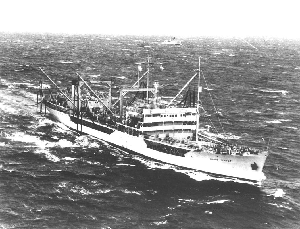RFA Wave Chief (A265)
 |
|
| History | |
|---|---|
|
|
|
| Name: |
|
| Owner: |
|
| Operator: | Royal Fleet Auxiliary (1946-74) |
| Builder: | Harland and Wolff, Govan |
| Yard number: | 1306 |
| Launched: | 4 April 1946 |
| Commissioned: | 30 July 1946 |
| Decommissioned: | August 1974 |
| Identification: |
|
| Honours and awards: |
Korea, 1951–53 |
| Fate: | Scrapped 1975 |
| General characteristics | |
| Tonnage: | 8,187 gross register tons (GRT) |
| Displacement: | 16,483 tonnes full load |
| Length: | 492 ft 8 in (150.16 m) |
| Beam: | 64 ft 4 in (19.61 m) |
| Draught: | 28 ft 6 in (8.69 m) |
| Propulsion: | 2 x Metrovick double reduction geared steam turbines, 6,800 hp (5,100 kW). |
| Speed: | 14.5 knots (26.9 km/h) |
RFA Wave Chief was a Wave-class fleet support tanker of the Royal Fleet Auxiliary that was built in 1946 as SS Empire Edgehil by Harland & Wolff, Govan, Renfrewshire, United Kingdom.
She saw service during the Korean War, earning a battle star. Wave Chief also served in the First Cod War and Second Cod War against Iceland. She was extensively modified in the early 1960s and escorted Sir Alec Rose around Cape Horn, South Africa, in April 1968. She was decommissioned and laid up at Rosyth, Fife, in August 1974, and arrived at Inverkeithing, Fife, for scrapping on 13 November 1974.
The ship was built by Harland & Wolff, Govan, Renfrewshire. She was yard number 1306.
The ship was 492 feet 8 inches (150.16 m) long, with a beam of 64 feet 4 inches (19.61 m). She had a draught of 28 feet 6 inches (8.69 m). She was assessed at 8,187 GRT.
The ship was propelled by two steam turbines, double reduction geared, driving a single screw propeller . The turbines ware made by Metrovick, Manchester, Lancashire. They could propel her at 14.5 knots (26.9 km/h).
Empire Edgehill was launched on 4 April 1946. On 27 July 1946, she was transferred to the Admiralty and three days later she was completed as Wave Chief, allocated the United Kingdom Official Number 180935 and the pennant number X119.
...
Wikipedia
